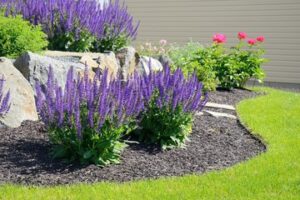Landscaping Fayetteville AR is a design process that incorporates both plants and structural modifications to outdoor areas. It encompasses everything from a simple garden to a public park.

Landscapes must be built with the environment in mind. For example, a mountain landscape requires plants that are adapted to the climate and soil conditions.
A well-thought out irrigation system is an essential part of a successful landscaping plan. Often overlooked, the proper watering of lawns and gardens is critical to reduce overwatering, soil erosion, runoff, pollution from fertilizers, and excessive water usage that results in costly utility bills.
There are a variety of irrigation systems available to Northwest Ohio homeowners, and each is best suited for certain landscaping types and plants. Some irrigation methods, such as surface and sprinkler irrigation, are more suitable for large properties with turf grass, while others, like drip irrigation, can provide more precise watering for non-turf areas, such as flower beds, ground cover, vegetable or perennial gardens, street medians, and hanging baskets.
One of the oldest and most basic irrigation methods, surface irrigation relies on gravity to distribute water throughout a landscape. This can include basin irrigation, which floods small areas around trees and garden beds; furrow irrigation, which channels water in rows between crops; or border irrigation, which flows water down strips separated by borders and is good for gently sloping fields. Cost-effective, this method is easy to set up and requires little maintenance. However, it is less effective in areas with frequent rainfall and can be inefficient if the water isn’t directed accurately.
Manual irrigation involves using hoses and other handheld tools to water individual plants or yards. This approach offers the flexibility to water specific areas and gives homeowners control over watering routines. However, this method can be time-consuming and inefficient if not consistently maintained.
The type of soil on your property will also influence your irrigation needs. Clay soils absorb and retain water very well, while sandy soils tend to dry out quickly and require more frequent watering. In general, most yards utilize a combination of different irrigation styles to best suit their individual landscaping needs and conditions.
A professional commercial landscaper is a valuable asset for businesses looking to save on utility costs while providing attractive and functional outdoor space. Hittle Landscaping offers a range of affordable landscaping services to meet the needs of commercial property owners and managers. Contact us to learn more about our comprehensive lawn and garden care, including custom irrigation systems.
Lawn Irrigation
When it comes to a well-kept landscape, one of the most important aspects is ensuring your lawn and plants receive adequate water. A quality irrigation system helps keep your property looking beautiful and healthy, reducing maintenance and saving you money on utility bills. There are a few different types of irrigation systems, and the best one for you depends on your budget, yard size, and water usage priorities. Here’s a look at some of the options to help you make an informed decision.
Manual irrigation uses hoses or watering cans to water your lawn and garden. This method is time-consuming and inefficient, but it can be useful for small yards or specific areas with unique watering needs. Automatic sprinkler systems are more efficient than manual methods, allowing you to set up a schedule that wateres your lawn at the optimal times. They also prevent overwatering and waste by ensuring that only the amount of water needed is applied.
Choosing the right irrigation system is essential for your lawn’s health and preventing invasive weed growth. According to the Natural Resources Conservation Service (NRCS), most lawns need to be irrigated every four to eight days, but it is important not to over-water. Too much water can drown the roots and cause weed growth. Overwatering also depletes the soil of nutrients and can create a hard, compacted layer that is difficult to penetrate, leading to poor root health and a shallower rooted plant.
The type of grass and soil in your yard also impact the watering needs of your lawn. For example, sandy soil may require more frequent watering than clay soil because it is harder to absorb and holds moisture less tightly. Changing your watering schedule based on the weather can also minimize overwatering and water loss.
Efficient irrigation systems can also help you meet local water conservation goals. Using smart irrigation systems with features like rain and freeze sensors reduces water waste by automatically shutting off the system when it’s raining or freezing. Regular maintenance activities like adjusting sprinkler heads, fixing leaks, and ensuring proper pressure can also eliminate water waste and save you gallons of water over the course of a year.
Sprinkler Irrigation
Sprinkler irrigation distributes water on crops with sprinklers that simulate precipitation, making it ideal for lawns, gardens and residential applications. It allows an intelligent management of the distribution and quantity of water supplied thanks to new technological systems that schedule irrigation shifts.
Sprinklers are suited for a variety of soil types and are often more economical than furrow irrigation for high-value crops, like vegetables and fruits, that require precise watering conditions. This type of irrigation reduces water loss due to evaporation and runoff. It also provides better control of water application rates, preventing waterlogging in some areas and dryness in others.
It is also an excellent choice for sloping land. It can be designed to irrigate hillsides, valleys and other landscape features, as well as orchards and vineyards, which may otherwise be difficult to grow without specialized watering techniques.
Depending on the location of the field, it is important to consider water supply conditions, including the soil infiltration rate and the amount of water holding capacity. It is also necessary to take into account the terrain, as steep slopes may impact watering and soil erosion.
For orchards and vineyards, a micro-sprinkler irrigation system is usually the best option. These are usually made up of a network of tubing or pipes that have small holes, called emitters. These release the water droplets into the soil at a slow rate, which minimizes erosion and evaporation and ensures that plants get enough water to grow properly.
These irrigation methods can be complicated, but with a little research, they can help you save money on your water bill while keeping your yard looking its best. A professional can also provide advice and recommendations based on your specific situation, which will result in more effective and efficient watering. Using an automated irrigation system can also make your job much easier, and you’ll be able to focus on more fun projects. For more ideas, check out these great DIY landscaping projects that will boost your home’s value and your own satisfaction.
Rain Irrigation
A rain irrigation system can reduce watering expenses and improve the health of your garden, lawn, or flower beds. This type of irrigation delivers water directly to the root zone, in small amounts at precise times. The specialized technology used in these systems can minimize evaporation, soil erosion, and the over-watering of plants that can lead to their death. In addition, the precision of a rain irrigation system means your plants get exactly what they need, when they need it.
Landscaping involves the design, construction, and maintenance of outdoor areas like gardens, parks, homes, or office buildings. It includes modifying the terrain to create more usable space and improving aesthetics with plants, stones, mulch, paths, patios, lighting, or water features. It also involves regular care like pruning, watering, and pest control. Landscaping can also help to reduce noise, increase privacy, and make an area more comfortable to relax or entertain in.
Landscapes can be designed to suit a wide range of styles, from natural to formal. Some examples include a cottage garden, a Japanese garden, or a European-style courtyard. Landscaping can also incorporate sustainable practices, such as using native plants that adapt to the climate and soil conditions, avoiding excessive fertilization or chemical inputs, and using water wisely by using drip irrigation or smart irrigation controllers.
The main objective of landscaping is to create a beautiful, functional, and healthy environment that will enhance the value of your property. You can achieve this by balancing nature and structure, choosing plant species that thrive in your climate and by adding hardscapes such as walkways, fences, and decorative stone elements to the yard.
The best way to protect your investment is by working with a professional, experienced landscaping company. They can help you develop a plan that is consistent with your vision, fits your budget, and will work well in the long-term. Then, they can help you implement the project in a timely manner and with minimal disruption to your daily routine.
